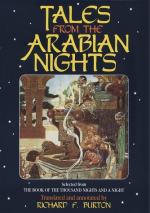[FN#108] In the H. V. the mother takes the “fruits” and places them upon the ground, “but when darkness set in, a light shone from them like the rays of a lamp or the sheen of the sun.”
[FN#109] For these fabled Giant rulers of Syria, Og King of Bashan, etc., see vols. vii. 84; ix. 109, 323. D’Herbelot (s. v. Giabbar= Giant) connects “Jababirah” with the Heb. Ghibbor Ghibborim and the Pers. Div, Divan: of these were ’Ad and Shaddad, Kings of Syria: the Falast"in (Philistines) ’Auj, Amalik and Banu Shayth or Seth’s descendants, the sons of God (Benu-Elohim) of the Book of Genesis (vi. 2) who inhabited Mount Hermon and lived in purity and chastity.
[FN#110] The H. V. explains that the Jinni had appeared to the mother in hideous aspect, with noise and clamour, because she had scoured the Lamp roughly; but was more gentle with Alaeddin because he had rubbed it lightly. This is from Galland.
[FN#111] Arab. Musawwadatayn = lit. two black things, rough copies, etc.
[FN#112] Arab. Banu Adam, as opposed to Banu Elohim (Sons of the Gods), B. al-Jann etc The Banu al-Asfar = sons of the yellow, are Esau’s posterity in Edom, also a term applied by Arab historians to the Greeks and Romans whom Jewish fable derived from Idumaea: in my vol. ii. 220, they are the people of the yellow or tawny faces. For the legend see Ibn Khall. iii. 8, where the translator suggests that the by-name may be = the “sees of the Emperor” Flavius, confounded with “flavus,” a title left by Vespasian to his successors The Banu al Khashkhash = sons of the (black) poppy are the Ethiopians.
[FN#113] Arab, Ha! ha! so Haka (fem. Haki) = Here for thee!
[FN#114] So in Medieval Europe Papal bulls and Kings’ letters were placed for respect on the head. See Duffield’s “Don Quixote,” Part i. xxxi.
[FN#115] Galland makes the Juif only ruse et adroit.
[FN#116] Arab. “Ghashim” = a “Johnny Raw” from the root “Ghashm” = iniquity: Builders apply the word to an unhewn stone; addressed to a person it is considered slighting, if not insulting. See vol. ii. 330.
[FN#117] The carat (Kirat) being most often, but not always, one twenty-fourth of the diner. See vols. iii. 239; vii. 289.
[FN#118] Kanani, plur. of Kinninah.
[FN#119] Here and below silver is specified, whenas the platters in Night dxxxv. were of gold This is one of the many changes’ contradictions and confusions which are inherent in Arab stones. See Spitta-Bey’s “Contes Arabes,” Preface.
[FN#120] i.e., the Slave of the Lamp.
[FN#121] This may be true, but my experience has taught me to prefer dealing with a Jew than with a Christian. The former will “jew” me perhaps, but his commercial cleverness will induce him to allow me some gain in order that I may not be quite disheartened: the latter will strip me of my skin and will grumble because he cannot gain more.




